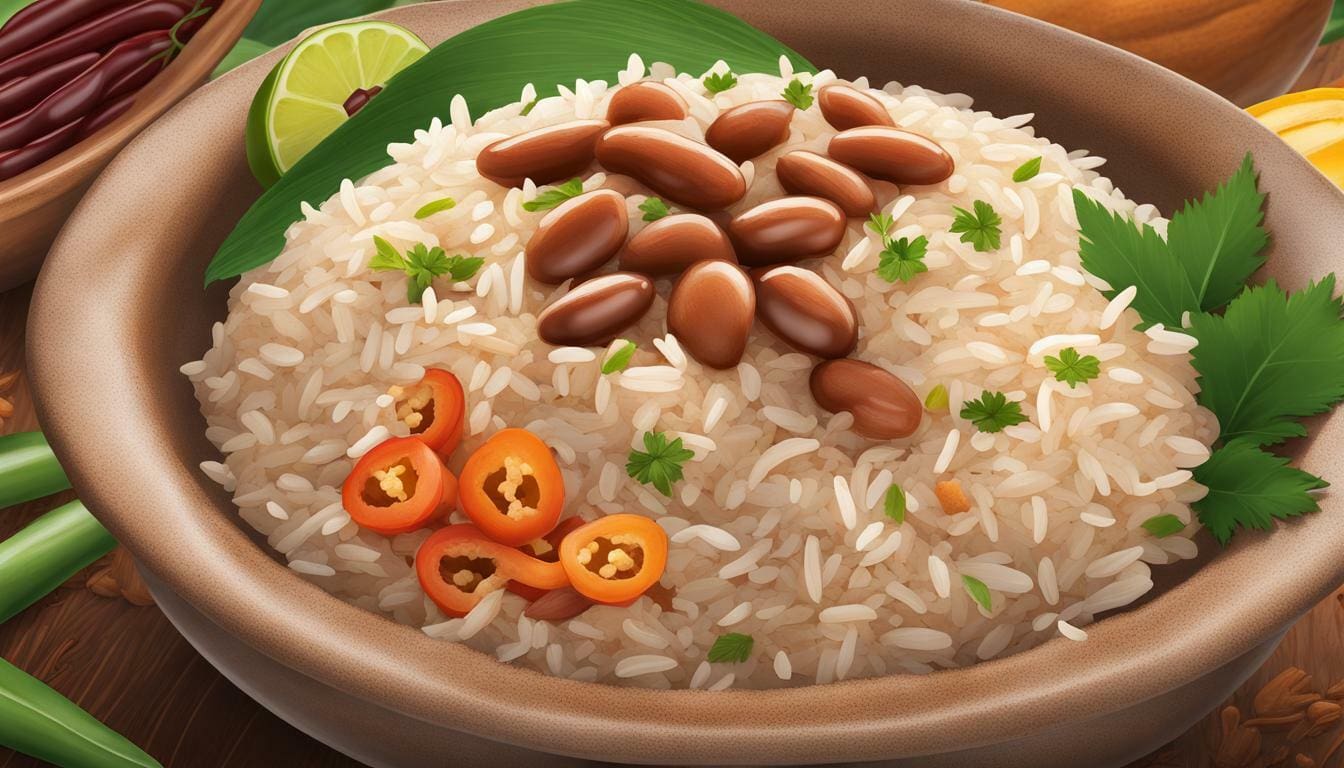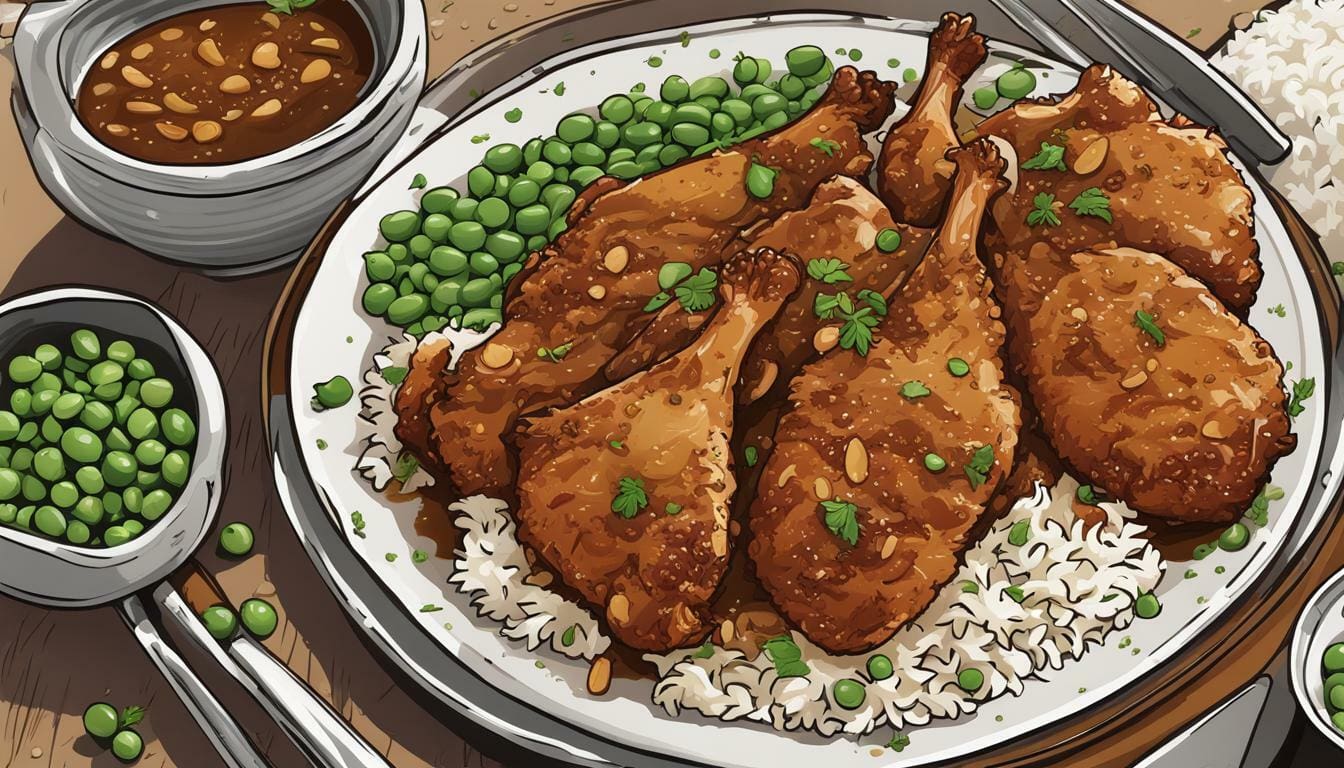Curry and rice go together like peas in a pod. But with so many rice varieties out there, how do you choose the right one to complement those aromatic curry spices?
Whether it’s a creamy korma or a fiery vindaloo, the rice you pair it with can make or break your curry experience. Using rice that clumps together turns your curry into a mushy mess. On the other hand, light, fluffy grains absorb the curry flavors perfectly.
This guide will take you through the rainbow of rice options ideal for curry dishes. You’ll uncover how to cook each variety to perfection and hear tips from my adventures in India discovering how locals artfully pair rice with their curries.
So let’s begin our rice journey to find your perfect curry companion!

The Classic: Basmati Rice
Basmati has been the rice of choice for Indian curries for centuries. Its fluffy, elongated grains provide the perfect canvas for curry flavors to shine.
During my travels in India, I learned first-hand why home cooks unanimously choose Basmati. Watching my host Rhea cook up a daily curry in her Mumbai apartment, I asked her why Basmati is so popular.
“The lightness of the grains allows the pungent spices to seep in, while still maintaining the rice’s integrity,” she explained. “And that unmistakable aroma heightens the overall curry experience.”
When cooking Basmati rice for curry, it’s key to wash it thoroughly pre-cooking. This prevents the grains from sticking together, yielding that desirable fluffy effect. Use a 1:2 ratio of rice to water and add a pinch of salt or turmeric for enhanced flavor.
Creative Basmati Rice Recipes
- Coconut Cashew Basmati: Add shredded coconut and roasted cashews for texture
- Saffron and Cardamom Basmati: Infuse with aromatic saffron threads and cardamom pods
- Turmeric Lime Basmati: Brighten up with lime zest and turmeric for color
The Fragrant: Jasmine Rice
Jasmine rice brings its own scent to the curry party. The jasmine flower aroma nicely complements curries without overpowering their spices.
When I was tasting curries at a street food stall in Bangkok, the vendor insisted I try it with Jasmine rice. The nutty, floral tones balanced perfectly with the rich Thai panang curry.
Compared to Basmati, Jasmine rice sticks together more easily. Soaking it for 15-30 minutes before cooking improves fluffiness. Use a 1:1 ratio of rice to water for the ideal pillowy texture to soak up that scrumptious curry sauce.
Creative Jasmine Rice Recipes
- Coconut Milk Jasmine: Infuse with coconut milk for sweetness
- Turmeric Roasted Jasmine: Toast with turmeric and garlic for depth
- Cilantro Lime Jasmine: Brighten with cilantro and lime juice
The Sticky: Short Grain Rice
Short grain rices like Japonica are ideal for Asian curry dishes where a little stickiness enhances the experience. The plump grains cling together, allowing you to easily pick up bites soaked in rich curry sauce.
While traveling around Japan, I frequently indulged in curry rice, comfort food made with short grain rice. The texture was perfect for dredging up the thick Japanese curry.
For light fluffiness, soak short grain rice before cooking. Use a 1:1.5 rice to water ratio. The starch released makes the grains cling together, ideal for holding scoops of scrumptious curry.
Creative Short Grain Rice Recipes
- Turmeric Brown Rice: Swap white for nutty brown rice
- Sesame Short Grain: Toast sesame seeds to mix in
- Japanese Curry Rice: Make it authentic with Japonica
The Toothsome: Long Grain Rice
Long grain rices like Carolina or Patna provide a heartier, chewier texture. Their firm structure stands up well to hearty meat and bean-based curries.
During a work trip in Chennai, my colleague Rajesh invited me home for dinner. His wife Maya prepared a robust goat curry paired with local long grain rice. The grains’ satisfying chew absorbed the rich gravy while maintaining a pleasant al dente bite.
Cook long grain rice with a 1:2 rice to water ratio for the right consistency to match with thick, hearty curries. For an aromatic flavor boost, try cooking in coconut milk or bone broth.
Creative Long Grain Rice Recipes
- Coconut Milk Long Grain: Simmer in coconut milk for creaminess
- Cinnamon Brown Rice: Stir in cinnamon sticks for warmth
- Chicken Broth Rice: Use chicken broth for savory depth
The Nutritious: Brown Rice
The earthy, nutty flavor of brown rice pairs nicely with equally hearty curries. Whole grains provide more nutrition to balance out rich curry dishes.
While taking a Thai cooking class in Chiang Mai, I noticed the instructor paired massaman curry with brown rice instead of white. She explained brown rice’s chewy texture and wholesome quality complemented the curry’s savory nutty flavors.
To achieve fluffy brown rice, use a 1:2 rice to water ratio with a longer cooking time. Natural oils in brown rice make it more prone to sticking, so watch the pot to ensure the grains cook evenly.
Creative Brown Rice Recipes
- Turmeric Brown Rice: Beautiful golden hued rice
- Garlic Brown Rice: Toasted garlic adds great flavor
- Coconut Curry Brown Rice: Infuse with coconut milk while cooking
The Convenient: Instant Rice
When time is short, instant rice provides a quick curry fix. The pre-cooked dehydrated grains simply need rehydrating in hot liquid.
My friend Neil swears by keeping a box of instant rice in the pantry for impromptu curry nights. He says it has a decent fluffy texture and cuts meal prep time significantly.
To use instant rice for curry, simply rehydrate with equal parts boiling water or broth, fluffing with a fork. For more flavor, try coconut milk or incorporate spices, herbs and aromatics into the cooking liquid.
Creative Instant Rice Recipes
- Vegetable Broth Rice: Use vegetable broth for the liquid
- Coconut Curry Rice: Rehydrate in coconut milk
- Cilantro Lime Rice: Stir in cilantro and lime juice
Off the Beaten Path: Unique Rice Varieties
Beyond traditional white rices, get creative with these unique varieties that lend their own spin to curries.
Black Rice
While sampling curries at a restaurant in Bali, the black rice underneath piqued my interest. The purple-red grains added visual appeal and a nutty taste that paired well with the complex rempah spice paste.
Red Rice
During a Kerala temple feast, I was served curries with brilliant red rice. The rice’s striking color and subtle sweetness balanced the meal’s potent spices.
Wild Rice
A friend makes duck curry with wild rice for a fun twist. The wild rice’s robust, woodsy flavor stands up well to the bold curry.
Choosing Your Perfect Curry Rice Partner
With this rice rainbow guide, you can confidently choose the right foundation for your curry dishes. Keep these tips in mind:
- Light curries – Basmati or Jasmine rice
- Rich curries – Short or long grain rice
- Spicy curries – Nutty brown or wild rice
- Mild curries – More neutral white rices
- Meat curries – Chewy long grain or brown rice
- Seafood curries – Light and fluffy white rice
Flavor and texture both play a role. Try out different rice varieties until you find your perfect match. And don’t be afraid to get creative mixing and matching for a unique curry experience!
Flavor Flubs: Common Rice and Curry Pairing Mistakes
While proper rice pairing enhances your curry, the wrong choice can ruin the experience. Avoid these common flavor flubs when selecting your curry rice partner:
Using Sticky Rice with Dry Curries
Sticky short grain rice clumps together, absorbing all sauce and leaving dry curry grains behind. Opt for fluffier Basmati or Jasmine.
Pairing Light Rice with Heavy Curries
Watery white rices wash away rich curry flavor instead of soaking it up. Choose a sturdier brown, wild or long grain rice.
Serving Instant Rice with Spicy Curries
The blandness of instant rice disappoints when paired with intensely spiced curries. Pick rice with its own flavor like Basmati.
Not Adjusting Rice Texture for Curries
Rice that’s overcooked to mush doesn’t complement any curry. Perfect the recipe to achieve your desired fluffy, sticky or chewy texture.
Forgetting to Season the Rice
Lack of seasoning makes rice bland and boring. Jazz it up with spices, herbs, broths, coconut milk and more.
The Final Bite: Choosing the Perfect Grains for You
Rice and curry share a timeless, passionate partnership. With so many options, experiment freely with different rice textures, flavors and colors at your curry feast.
Keep this guide close as you embark on your own rice-picking adventures. Let the grains inspire you to create signature rice blends and curries suited to your tastes.
The right rice can make your curry soul-satisfying comfort food. But the wrong choice crushes curry dreams. Follow these tips to find your perfect match:
Q: Which rice is the most lightweight and fluffy for curries?
A: Basmati rice. Its elongated grains yield a fluffy, distinct texture ideal for soaking up curry flavors.
Q: What’s the difference between Basmati and Jasmine rice for curries?
A: Basmati rice has a fluffier, lighter texture. Jasmine rice lends its own fragrant aroma. Both absorb flavors well.
Q: Is sticky or long grain rice better for curries?
A: It depends on the curry. Sticky rice complements saucy Asian curries. Long grain suits heartier Indian curries.
Q: Can you use brown or wild rice for curries?
A: Yes! Their nutty flavor and chewy texture provides delicious contrast with rich curries.
Q: What rice goes best with Thai red or green curry?
A: Jasmine rice perfectly suits the flavors of Thai curries. The subtle jasmine aroma balances the bold spices.


